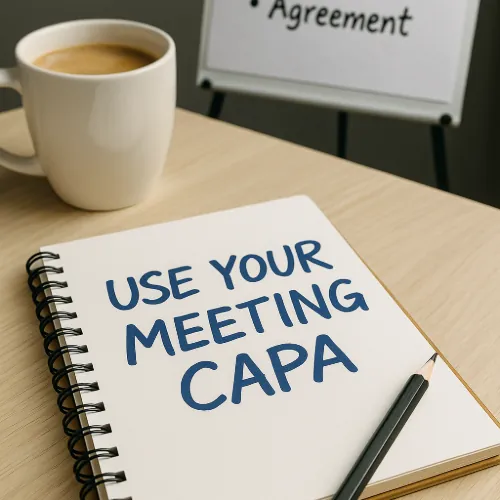Use your Meeting CAPA – Four Steps to Turn Meetings into Decisions

Everyone knows the feeling: another meeting ends, and nobody’s sure what was decided. The consequence? Full calendars, delays everywhere - and everyone feels meetings are a drag, but there seems to be no way out.
The problem isn’t the people. Most would like things to be different, but they don't know how. What is happening? Meetings often miss the four components of closure that make decisions stick. Without them, conversations drift, topics resurface, and discussions spin in circles.
We'd like to make your meetings better with Meeting CAPA: four simple steps that transform meetings from time sinks into decision engines.
The Meeting CAPA
Over the years, we have observed a couple patterns that can be found in every successful meeting:
C – Context
Start out by answering, Why are we here? What’s the situation, and what’s the intent?
It was the quarterly program Retrospective of a large Corporate program - everyone had an opinion what needed to be addressed, and we quickly got into deep discussions of everyday processes. Until, one hour later, the program's director excused themselves, "I'm sorry - I don't think I can add anything of value."
They had come to be a decision instance, and get the team unblocked - but the team was completely unprepared, and couldn't even agree on their situation.
It would have been so easy to prepare the meeting ahead of time, "This is our biggest problem, and that's how it's affecting us. We'd like to
find a solution that works for everyone - teams and management alike." When we asked teams to agree on the situation and desired outcome beforehand,
management suddenly found themselves much more involved and they started praising the teams for the good prep.
Without sufficient context, people talk past each other. With context, everyone starts on the same page. Context is the anchor that prevents a meeting from becoming a free-for-all of assumptions and side quests.
The Fix: Begin with a simple structure that names the situation and intent: “We’re here because X is affecting Y, and we need to decide Z.”
A - Action
What’s the proposal, and who owns it?
Don't ask me how many meetings I've had where people brought forth "shoulds" - expectations that someone should do something, but without ownership or commitment. With one client, it was so pervasive that we spent months discussing the same topic, without any energy put into actual motion. When I simply rolled up my sleeves and did something, everyone felt it to be extremely refreshing. Even when the results were not nearly as exciting as I'd wanted them to be.
Without action, meetings become therapy sessions for problems. With action, there’s a concrete path forward. And every action must come with ownership: a plan without a “who” is just another idea waiting to die.
The Fix: Pair every proposal with accountability: “We propose X, and Y will do it.”
P - Perspectives
Did we miss something? Any concerns? Questions?
I once worked with a middle manager who would never wave a plan through. He would always address every person individually, "Your take?" Most of the time, people just nodded, "I'm good." This ritual didn't cost much time, but it was an accountability ritual: "If you say now that we covered everything - don't come later, Could Have, Should Have." No: We always do the best we can, given the information we have.
Asking people for their perspectives helps us close blind spots and avoid obvious pitfalls. Others may also surface options or alternatives we haven't considered. It doesn't have to be an endless discussion, but it's not just an opportunity for others to speak - it's an opportunity for ourselves to de-risk.
The Fix: Ask explicitly: "Before we proceed, is there anything we should consider or that's not clear?"
A - Agreement
Is everyone in?
An international corporation struggled with decisions, because decision-makers would often leave before a decision point had been reached, and the others didn't feel empowered to decide by themselves.
Simply following up with an email summarizing the situation, plan and going toward implied consensus put wind into the sails and started the discussions
that hadn't happened before: surfacing the issues that led to a "no."
Without explicit agreement, meetings end in ambiguity. Agreement generates shared commitment, clarity, and closure. When we agree, option becomes decision.
The Fix: End every meeting with: "Do we all agree to proceed on this?"
When you lack CAPA
If any or all of the CAPA components are missing, your meetings become dysfunctional.
- No context: People talk past each other or fix the wrong problem.
- No action: Nothing changes.
- No perspectives: Risks surface too late or people feel underappreciated.
- No agreement: The same topic resurfaces next week.
Without CAPA, "one short meeting" quickly multiplies into a crowded calendar, and generate invisible waste until deadlines slip, trust erodes, and teams burn out.
From CAPA to Closure
CAPA gives you the human discipline for closure. It doesn’t require a new methodology, just a new habit: always bring Context, Action, Perspectives, and Agreement into the room.
And if you want to go further: VXS is your CAPA engine. It makes context visible, surfaces possible misalignment, predicts implicit risks, and makes conflicting goals visible before the meeting even began. Thus, meetings stop being energy sinks and start producing clarity. With CAPA, you move. With VXS, you accelerate.